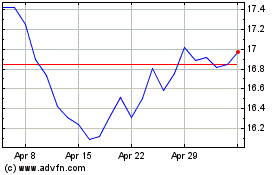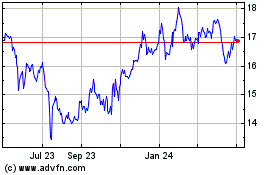VZ Stock: Is Verizon a Good Buy Right Now?
May 14 2021 - 10:35AM
Finscreener.org
When you invest in individual stocks you need to keep your risk
appetite in mind. For an individual nearing retirement, investing
in companies that have an established presence with a low beta
makes perfect sense. Alternatively, investors with a long-term
investment horizon can have exposure to small-cap stocks that are
more volatile.
If you are someone who wants to derive stable returns, you can
look at investing in recession-proof sectors such as telecom.
Companies part of the telecom sector provide an essential service
allowing them to perform well across business cycles. One such
stock that you can add to your portfolio is blue-chip telecom giant
Verizon (NYSE: VZ).
An overview of Verizon
Verizon offers communications, technology, information and
entertainment products and services to consumers, businesses and
government entities all around the world.
Its Consumer segment provides postpaid and prepaid service
plans, internet access and wireless equipment. Verizon also
provides residential fixed connectivity solutions and sells network
access to mobile virtual network operators. At the end of 2020, the
company had 94 million wireless retail connections, seven million
broadband connections and 4 million Fios video
connections.
Its Business segment provides network connectivity products that
include private cloud connectivity, virtual and software defined
networking, unified communications as well as internet access
services. This segment also offers a suite of management and data
security services in addition to global voice and data
solutions.
Recent quarterly results
Verizon is one of the largest telecom companies in the world and
in Q1 it managed to increase sales by 4% year over year to $32.9
billion. Its adjusted net income stood at $1.31 per share compared
to $1.26 in the prior-year period. Wall Street forecast the company
to post revenue of $32.47 billion and earnings of $1.29 per share
in the March quarter.
Verizon grew sales in each of its three operating segments.
While sales in the Consumer business was up 5% at $22.8 billion,
the Business segment sales inched higher by 1% to $7.8 billion and
the Media business grew top-line by a healthy 10% to almost $2
billion.
Verizon expects adjusted per share between $5 and $5.15 in 2021.
Driven by the rollout of its 5G network, the telecom heavyweight
will spend between $19.5 billion and $21.5 billion in capital
expenditures this year.
A Warren Buffett bet
Verizon is also part of Warren Buffett’s Berkshire Hathaway
(NYSE: BRK.A)(NYSE:
BRK.B)
portfolio. Warren Buffett likes dividends and Verizon stock
has a tasty forward yield of 4.26% making it really attractive to
income investors who want to beat inflation and generate a steady
stream of income.
For example, a $5,000 investment in Verizon stock will allow you
to derive over $210 in annual dividends. Further, in the last five
years the stock is up over 40%.
The company has a conservative payout ratio of less than 60%
allowing Verizon to reinvest in CAPEX and increase dividends over
time. Despite a tough 2020, the company generated over $18 billion
in cash flow. It now expects to increase earnings between 2% and 5%
in 2021. Verizon has increased dividends each year since 2007
making it one of the top dividend growth companies
on the S&P 500.
The verdict
Verizon ended Q1 with $137 billion in debt but it continues to
improve its leverage ratio. As the transition towards 5G gains
pace, Verizon is well-poised to become the top telecom company in
the U.S. and might displace AT&T (NYSE: T) from the
pole position.
Verizon stock is valued at a market cap of $242 billion which
means its price to sales multiple is less than 1.7x. Analysts
covering
the stock have an average 12-month price target of $60.1 which
is 4% above its current trading price. After accounting for its
dividend yield total returns will be closer to 8%.
AT&T (NYSE:T)
Historical Stock Chart
From Mar 2024 to Apr 2024

AT&T (NYSE:T)
Historical Stock Chart
From Apr 2023 to Apr 2024
